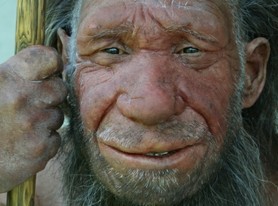They had bigger brains and muscles, but for some reason Neanderthals died out about 30,000 years ago, while we modern humans survived.
Why we, Homo sapiens, flourished and our Homo neandertalensis cousins died out after thriving for hundreds of thousands of years is an evolutionary mystery biologist are trying to unravel.
In the last few years, scientists have uncovered clues what the lives of Neanderthals may have been like. And those clues also tell us more about what it means to be a modern human.
(Discover if you have Neanderthal DNA with 23andMe’s DNA Ancestry Service, or sign-up for a membership to unlock even more ancestry insights.)

Ancient DNA
Most interesting of all is that, although Neanderthals disappeared long ago, their DNA lives on in all non-African people.
23andMe now offers a lab allowing customers to connect with their prehistoric roots.
The lab, developed by one of our resident computational biologists Eric Durand, compares two modern human genomes with the Neanderthal genome. It can then determine what percentage of your own DNA is Neanderthal. Before coming to 23andMe, Eric worked on the first draft of the Neanderthal genome and on analysis of the Denisova genome, another of our early human cousins. The lab uses the same method Eric helped develop while working at the Department of Integrative Biology at the University of California, Berkeley.
See Eric’s white paper for a technical explanation of the methodology.
Modern Humans
Most people have Neanderthal DNA, on average about 2.5 percent. But there are outliers, who have much more.
What it means to have a higher percentage of Neanderthal DNA – whether you’re hairier, or brutish or short, for instance – isn’t known.
There are some theories, however, of how Neanderthals contributed to modern humans. One is that interbreeding gave us some sort of “hybrid vigor,” according to Peter Parham, a geneticist at Stanford University School of Medicine.
At the very least research appears to support the theory that at some point during the tens of thousands of years Neanderthals and modern humans lived side by side, a few of them may have shacked up.
Or as Elizabeth Kolbert deftly phrased it in the New Yorker:
“Before modern humans ‘replaced’ the Neanderthals, they had sex with them.”
Provocative to say the least, but it’s actually an idea that’s floated around for some time.
Anybody who ever read Jean M. Auel’s saucy prehistoric romance books beginning with “Clan of the Cave Bear” could tell you that. But the notion that modern humans and Neanderthals got way past first base. They hooked up and even had children together still doesn’t tell us much about what it means now to have a smidgen of Neanderthal in your DNA.
Neanderthal Genome
Svante Paabo, the Swedish geneticist behind the sequencing of the Neanderthal genome, explains that from an evolutionary point of view. Comparing the modern human’s genome to that of the Neanderthal has great value, Paabo said.
Humans and Neanderthals share a common ancestor with chimpanzees – our next closest mammalian relative – that goes back between five and seven million years.
Comparing the human genome with that of chimps tells us a lot about evolution over millions of years. But by having the Neanderthal genome sequence – now 55 percent completed – and comparing that with modern humans, we can learn much more about evolutionary changes over the last 30,000 years.
It may be that the DNA of other prehistoric human groups also are intermixed in our own DNA.
Other Ancient Cousins
Much like with Neanderthals, scientists extracted ancient DNA from the skeletal remains of another ancient cousin known as the Denisovans. The remains – a finger bone – were found in a cave in Siberia and showed that Denisovans were cousins of Neanderthals. They lived in Asia and disappeared about 40,000 years ago. Their DNA is found today in Melanesians.
As for the comparisons with the Neanderthals, so far, Paabo’s team has found almost 80 genetic variants that are unique to modern humans. The function of these variants could help us understand what distinguishes us from Neanderthal.
Apparently Paabo’s work has also resonated beyond the scientific community as well.
At a talk late last year, Paabo told a group of neuroscientists that for months he’s been keeping emails from people who have claimed that they were Neanderthal and should be included in his study. Several women have written to him volunteering their husbands as subjects for study.
![]()
Got Neanderthal DNA?
23andMe customers can find their inner Neanderthal or at least how much Neanderthal DNA they have at 23andMe Ancestry Labs. Not yet a customer? Visit our store!




